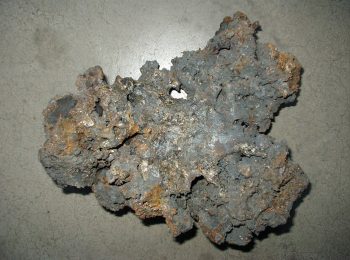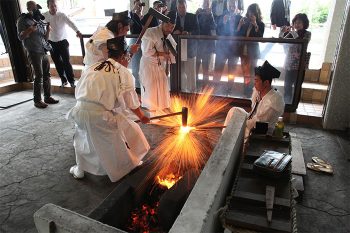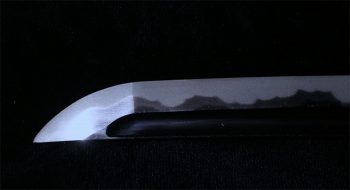I was interested to read an article from my colleague Alastair about the rise in interest in luggage and hand bags in the auction market. Not only are these bags finely made, but the rarity of their manufacture is making them both sought after and valuable pieces, increasing their prestige and elevating the status of their owners.
In the 21st century a bag or indeed a watch can mark out an individual as someone of some status and wealth.
During the 18th and 19th centuries in Japan the ruling class of the day, the Samurai, carried a sword as a symbol of power and status. The sword, even when its use was reduced with the invention of the gun, still gave the owner his warrior spirit well into the 20th century, even if the sword, like the one my grandfather liberated in the War, was poorly produced.
The Sword had almost mystical properties and when held in the hands of a Master, it was considered to be alive and have a spirit of its own. The men who made the sword were alchemists as they forged metal with fire and skill to produce objects that were both beautiful and lethal.
As you will no doubt know, the fictional character in Quentin Tarrantino’s film Kill Bill goes to Okinawa, an island famous for a type of Karate and the fact that it has a high number of Centenarians, to obtain a sword from a retired sword maker. He refuses to give her one from his collection but is obliged by his sense of honour to make a sword, which he says will take a month.
The production of a sword is a lengthy process, even in this century, so one suspects that either he has a stash of partly made swords in his shed or the film is not as accurately researched as this article. Making a sword is a rare and physical challenge, no less because blades can break in the tempering process, but also there are limited people who are skilled enough to manufacture them and the quality of steel to produce them is made in limited quantities.
A traditional Japanese sword is made from Tamahagane steel, which is made from two types of iron sand, a source of iron ore, heated to approximately 1000c in a Tatara, a type of clay furnace. The firing takes approximately 5-7 days and over this time iron sand and charcoal is sprinkled into a pre-made crucible in the middle of the pine charcoal fired furnace, and subjected to firing, until it is judged to be ready to retrieve. The furnace is broken open and a red-hot lump of precious steel is removed from the furnace, to be cooled and graded. The most important aspect of the steel is its carbon content as this will affect the durability of the blade.
Both traditional iron foundry’s and swordsmiths will work in a forge that is considered a shrine and they themselves may be honoured as national treasures. There is often a Shinto alter in the workshop and devotions are made every day to the Gods for the protection of the workers and the smith.

Tamahagane steel
The swordsmith will take delivery of a selection of pieces of steel that the foundry master has chosen. Normally these are found on the edges of the block of steel produced as they have most contact with air and carbon.
The blocks are arranged around a bar, covered in rice paper and clay slurry. The whole is heated in a furnace to 1200c and then hammered into a complete block, usually with two of the master’s apprentices. The hammering purifies the steel and the work reduces the initial weight of the ingot by 50%. The block is hammered to a plaque and the folded along its length continuously, creating a laminate of steel with multiple layers which ultimately gives the finished blade a grain.

A Japanese swordsmith with his assistants
The ultimate property of the sword blade is that it is strong, but flexible. The blade must be extremely sharp and hard, but it has to have a softer centre and back to gain flexibility. This flexibility is introduced to the sword by placing a softer iron interior to the blade, which is forged into it before the sword is formed. The initial ingot of steel is created into a long U cross section, into which the soft core is introduced and then the ingot can start to be unified and lengthened into a blade form, with the bevelled edge. The smith will work the blade meticulously as his work will add to the ‘fibre’ and construction of the steel. It will be well shaped before it is ready to tempered, a process of the hardening of the metal. He will also form the tang, a tongue like piece of metal onto which the sword fittings and hilt will be mounted. This tang is often signed by the maker.
When viewing a Japanese sword blade you will note that there is a pattern to the surface called a Hamon, a sort of cloud like effect that appears along its length which is separate to the folded gain of the steel. This is created when the blade is hardened. A mixture of clay and carbon in the form of a slurry is painted over the blade, protecting the softer elements. A pattern is created in the slurry that is unique to the swordsmith and adds an artistic expression to the blade. The blade is then heated to approximately 800c and when the smith judges it to be ready and hot enough, it is plunged into cold water. The areas of the steel which receive a thinner coat of clay slurry become very hard and will take the edge of the weapon. The areas with a thicker clay coating will cool less rapidly preserving the flexibility of the sword blade. The cooling and tempering process also forms the curve and shape of the blade.

The Hamon of a Japanese sword
The blade is now ready to undergo polishing, which in the first instance will be done by the swordsmith to check for imperfections in the blade, but then will be sent to a master blade polisher. It will be his job to refine the surface of the blade, revealing all the smiths work, the hamon created in the tempering process and sharpening the blade to a razer like edge capable of cutting blades of hair or realistically flesh and bone. He will use various grades of stone, clays and powders to grind and polish the blade to a mirror like finish. This process is approached with some trepidation as the polisher must avoid cutting himself on the edge of the sword, but still achieve a beautiful finish.
Once the blade is made it will be stored in a protective wooden case, called a Shirasaya. This is made of two parts, one to house the blade and one to house the hilt. The hilt part is drilled with one or two holes which have corresponding holes in the tang of the sword, and wooden pegs, called Mekugi, hold the blade into the hilt piece.
There are generally five types of sword seen on the market known as katana, tsurugi, wakizashi, odachi and tanto, each with a defined length, the shortest a tanto being a dagger form.
Rachel brings over 30 years of experience in the Art & Antiques industry and over the past fifteen years she has been responsible for looking after both clients and professional advisers with their valuation needs.







